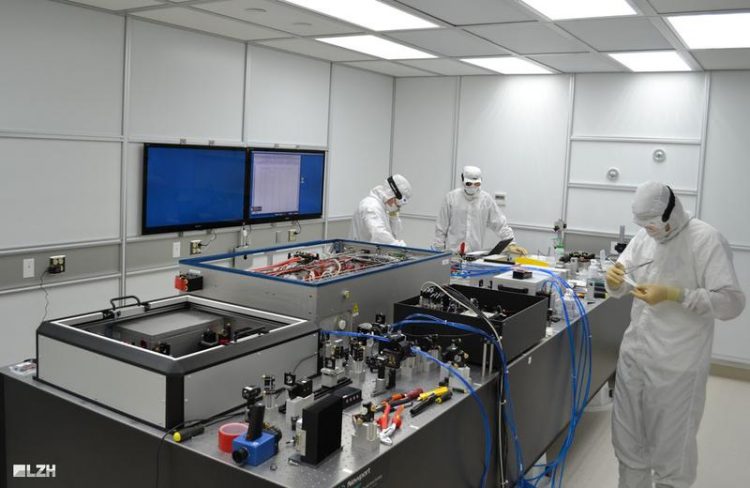Milestone in physics: gravitational waves detected with the laser system from LZH

Installation of the LZH lasers in the LIGO cleanroom, Livingston (US). LZH
The resulting gravitational wave was measured already in September 2015; yesterday, the evaluation of the data was published in the Physical Review Letters and presented to the world press.
For more than ten years, the AEI and the Laser Zentrum Hannover e.V. (LZH) have put R&D efforts into the development of laser systems for the LIGO (Laser Interferometer Gravitational Wave Observatory) gravitational wave detectors.
The lasers of the LIGO detectors were jointly manufactured and integrated into the US observatories as a ready-to-run system by the LZH, the AEI and the LZH spin-off company neoLASE. The gravitational wave detected now was recorded by the Enhance LIGO (eLIGO) model.
The Advanced LIGO (aLIGO) systems that were put into operation in the meantime have a five times higher output power compared to the previous lasers. Under these circumstances, chances to detect further gravitational waves are significantly higher.
With this high-tech measurement instrument, a reliable basis was created for future research in gravitational physics in Hannover and worldwide.
AEI press release: www.aei.mpg.de/gwdetection
LIGO press release: www.ligo.org/news/media-advisory.php
http://www.lzh.de/en/publications/pressreleases/2012/anotherhighpowerlaserforthe…
Media Contact
All latest news from the category: Physics and Astronomy
This area deals with the fundamental laws and building blocks of nature and how they interact, the properties and the behavior of matter, and research into space and time and their structures.
innovations-report provides in-depth reports and articles on subjects such as astrophysics, laser technologies, nuclear, quantum, particle and solid-state physics, nanotechnologies, planetary research and findings (Mars, Venus) and developments related to the Hubble Telescope.
Newest articles

First-of-its-kind study uses remote sensing to monitor plastic debris in rivers and lakes
Remote sensing creates a cost-effective solution to monitoring plastic pollution. A first-of-its-kind study from researchers at the University of Minnesota Twin Cities shows how remote sensing can help monitor and…

Laser-based artificial neuron mimics nerve cell functions at lightning speed
With a processing speed a billion times faster than nature, chip-based laser neuron could help advance AI tasks such as pattern recognition and sequence prediction. Researchers have developed a laser-based…

Optimising the processing of plastic waste
Just one look in the yellow bin reveals a colourful jumble of different types of plastic. However, the purer and more uniform plastic waste is, the easier it is to…


